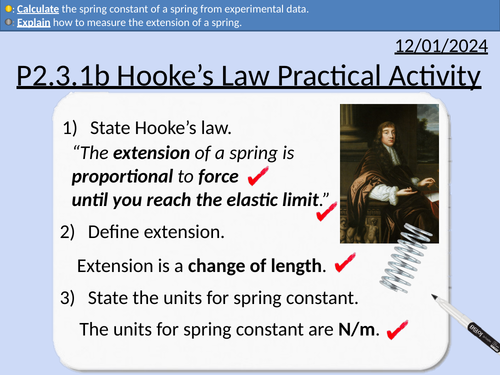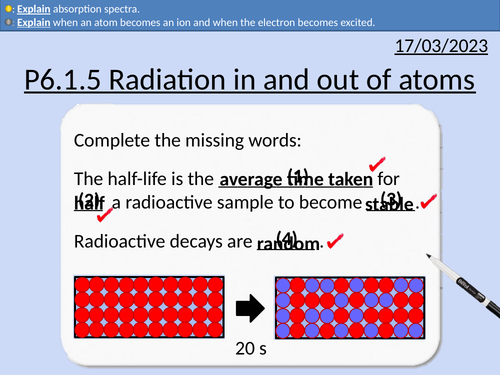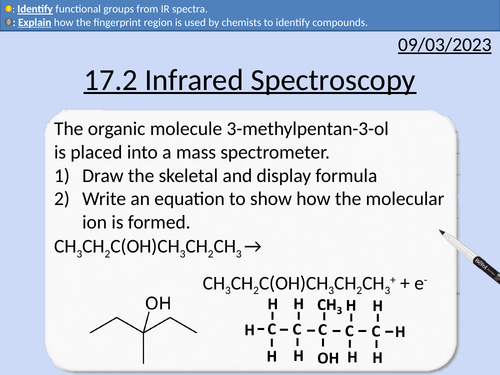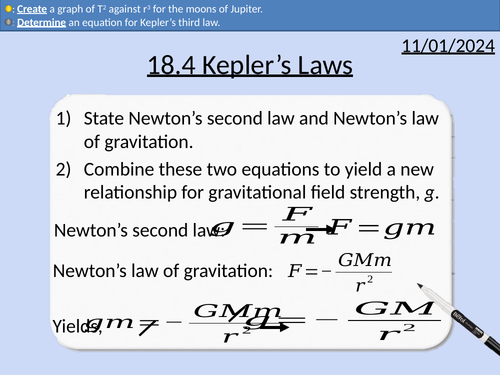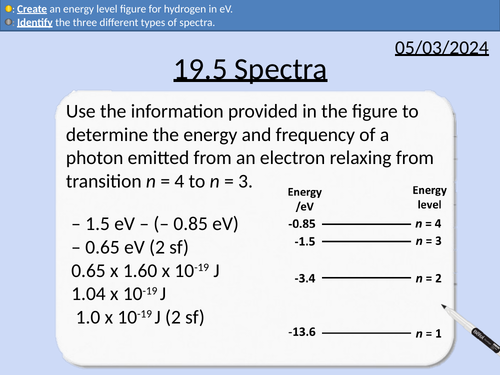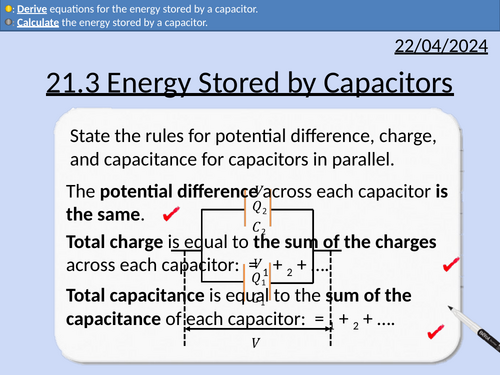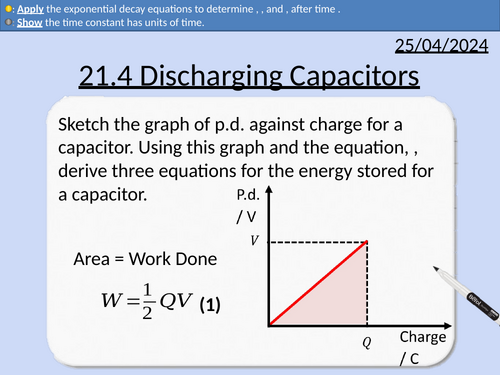496Uploads
163k+Views
70k+Downloads
All resources

OCR AS level Physics: Resistance and Resistivity
OCR AS level Physics: Resistance and Resistivity is a part of the Module 4: Electrons, Waves, and Photons. PowerPoint with worked examples and homework.
Factors affecting resistance
Calculating resistivity
Resistivity and temperature
Experimentally determining resistivity
Using a graph to calculate resistivity

GCSE Chemistry: Exothermic and Endothermic Reactions
This PowerPoint presentation with worked examples and student questions covers:
• Definition for exothermic and endothermic
• Examples of exothermic and endothermic reactions
• Practical procedure for NaOH(aq) + HCl(aq) → NaCl(aq) + H2O(l)
• Determining if experimental evidence show a exothermic or endothermic reaction

GCSE Chemistry: The pH scale
This PowerPoint presentation with worked examples and student questions covers:
• pH 0 - 14 scale with household examples
• Definitions for acids, bases and alkali substances
• Universal indicator and pH probes
• Using equalities and inequalities

GCSE Physics: Hooke's Law Practical
This PowerPoint presentation with worked examples and student questions covers:
• Definition of Hooke’s Law
• Converting from centimeters to meters
• Converting from millimeters to meters
• Calculating the spring constant from a gradient of a force-extension graph
• The parallax effect and good experimental practice
• Data analysis (calculating mean and significant figures).

OCR AS Physics: Potential Dividers
OCR AS Physics A: Potential Divider is a part of the Module 4: Electrons, Waves, and Photons. PowerPoint with worked examples and homework.
Application of the ratio of resistances
Application of the potential divider circuit
Deriving the potential divider equation
Rearranging the potential divider equation

GCSE Physics: Absorption and Emission Spectra
This presentation covers OCR Gateway Physics 9-1 P6.1.5 Radiation in and out of atoms.
This PowerPoint is a whole lessons included with student activities and animated answers.
Arrangements of electrons and distance from the nucleus
Electron energy levels
Absorbing electromagnetic radiation
Electromagnetic radiation and energy
Absorption spectra
Emission spectra
Discovery of helium
Bundle

GCSE OCR Physics: P6 Radiation
All resources for GCSE OCR Physics Gateway 9-1 P6 Radiation.
Triple and combined (Higher and Foundation) is covered in this material.
Atoms and Isotopes
Alpha, Beta, and Gamma Radiation
Nuclear Equations
Half-life
Radiation and the body
Nuclear Fusion
Nuclear Fission
Radiation in and out of atoms

OCR AS Chemistry: 17.2 Infrared Spectroscopy
OCR AS Chemistry: 17.2 Infrared Spectroscopy
This PowerPoint is a whole lessons included with student activities, animated answers, homework questions with answers provided.
This lesson covers:
Absorb infrared radiation increasing vibrations
What determines the magnitude of vibration
Fingerprint region
Identifying peaks

A Level Chemistry: Introducing Benzene
OCR A level Chemistry: 25.1 Introducing Benzene
This PowerPoint is a whole lesson included with student activities, animated answers, homework questions with answers provided.
This lesson covers:
Molecular, empirical, skeletal formula for benzene.
The Kekulé model for benzene
Evidence against the Kekule model
The delocalised model for benzene
Nomenclature for benzene rings and aromatic (arene) compounds
Naming benzene containing compounds
Drawing benzene containing compounds
Bundle

OCR A level Chemistry: Amines, Amino Acids, and Polymers
OCR A level Chemistry: Aromatic Compounds is apart of the Module 6: Organic Chemistry and Analysis.
All presentations come with worked examples, solutions and homeworks.
27.1 Amines
27.2 Amino acids, Amides and Chirality
27.3 Condensation Polymers
Aliphatic and aromatic hydrocarbons
Amines being derived from ammonia (NH3)
Classifying amines as primary, secondary, and tertiary
Naming amines
Naming ammonium salts
Amines neutralisation reactions with acids
Preparation of aliphatic amines
Preparation of aromatic amines
Locants: alpha, beta, and gamma
Functional groups of amino acids
General formula for amino acids
Reactions of amino acids (alkali and acid)
Esterification of amino acids
Amide functional groups
Naming amide molecules
Drawing optical isomers
Explanation of superimposable and non-superimposable images
Identifying chiral centers
Recap of addition polymerisation
Identifying monomers and repeat units from condensation polymers
Polyesters and ester links
Polyamides and amide links
Polyesters and polyamides formed from one monomer
Polyesters and polyamide formed from two monomers
Alkali hydrolysis of polyamides and polyesters
Acid hydrolysis of polyamides and polyesters

A level Chemistry: Amines
OCR A level Chemistry: 27.1 Amines
This PowerPoint is a whole lesson included with student activities, animated answers, homework questions with answers provided.
This lesson covers:
Aliphatic and aromatic hydrocarbons
Amines being derived from ammonia (NH3)
Classifying amines as primary, secondary, and tertiary
Naming amines
Naming ammonium salts
Amines neutralisation reactions with acids
Preparation of aliphatic amines
Preparation of aromatic amines
Bundle

OCR A level Chemistry: Carbonyl and Carboxylic Acids
OCR A level Chemistry: Aromatic Compounds is apart of the Module 6: Organic Chemistry and Analysis.
All presentations come with worked examples, solutions and homeworks
26.1 Carbonyl Compounds
26.2 Identifying Aldehydes and Ketones
26.3 Carboxylic Acids
26.4 Carboxylic Acid Derivatives
The carbonyl group
Differentiating between aldehydes and ketones
Naming aldehydes and ketones
Oxidation of aldehydes
Electronegativity and polar bonds
Electrophiles, nucleophiles, and nucleophilic addition reactions
Reducing carbonyl compounds with sodium tetrahydridoborate(III) (NaH4)
Primary and secondary alcohols from carbonyl compounds
Reacting carbonyl compounds with hydrogen cyanide (HCN)
Reaction mechanisms for nucleophilic addition using (NaBH4)
Reaction mechanisms for nucleophilic addition using (HCN)
Testing for Carbonyl Groups
Brady’s reagent - 2,4-dinitrophenylhydrazine - 2,4-DNP
Distinguishing between Aldehydes and Ketones
Tollen’s reagent - silver nitrate in aqueous ammonia
The Carboxyl Group and polarity of bonds.
Naming carboxylic acids
Carboxylic acids as weak acids
Reactions of carboxylic acids with:
Metals
Metal oxides
Alkali
Carbonates
Changing solubility of carboxylic acids in water due to carbon chain length.
Naming acyl chlorides
Naming acid anhydrides
Naming esters
Esterification
Acid hydrolysis of esters
Alkali hydrolysis of esters
Producing acyl chlorides from carboxylic acids
Producing carboxylic acids from acyl chlorides
Producing esters from acyl chlorides and phenols
Primary, secondary, and tertiary molecules
Producing primary amides from acyl chlorides
Producing secondary amides with acyl chlorides
Producing esters and carboxylic acids wirh acid anhydride

OCR A Level Physics: Kepler’s Laws
OCR A level Physics: 18.4 Kepler’s Laws
This PowerPoint is a whole lesson included with student activities, animated answers, homework questions with answers provided.
This lesson covers:
The terms: eccentricity, aphelion, perihelion, astronomical unit
Kepler’s First Law
Kepler’s Second Law
Kepler’s Third Law
Graphs of T^2 against r^3 to determine the gradient (constant of proportionality, k).
Equating (4π)^2/𝐺𝑀 to the gradient (constant of proportionality, k)

OCR A level Physics: Spectra
OCR A level Physics: 19.5 Spectra
Module 5 Newtonian World and Astrophysics
This PowerPoint is a whole lesson included with student activities, animated answers, homework questions with answers provided.
This lesson covers:
The electromagnetic spectrum and wavelengths
Definition of spectroscopy
Electrons and energy levels
Continuous spectra
Emission spectra from gases
Absorption spectra from gases

OCR A level Physics: Energy Stored by Capacitors
OCR A level Physics: 21.3 Energy Stored by Capacitors
Module 6 Particles and Medical Physics
This PowerPoint is a whole lesson included with student activities, animated answers, homework questions with answers provided.
This lesson covers:
Work done of a capacitor depends upon the initial potential difference and capacitance.
Work done is provided by the source of potential difference.
Deriving three equations for work done of a capacitor.

OCR A level Physics: Discharging Capacitors
OCR A level Physics: 21.4 Discharging Capacitors
Module 6 Particles and Medical Physics
This PowerPoint is a whole lesson included with student activities, animated answers, homework questions with answers provided.
This lesson covers:
Exponential increase and exponential decay
Explaining how capacitors discharge through a resistor in parallel
Definition of time constant for a capacitor
Showing that time constant has units of seconds
Iterative method for finding how capacitors discharge
Using exponentials and logs.
Solving a differential equation (needed for A-level Maths).

GCSE Physics: Speakers and Microphones
This lesson presentations covers OCR Gateway Physics 9-1 P4.2.6 Speakers and Microphones.
Definition of sound waves.
Structure and operation of a speaker.
Fleming’s left hand rule.
Structure and operation of a microphone.
Electromagnetic induction.
Comparison of speakers and motors.
Comparison of microphone and generators.
Comparing microphones and speakers
Bundle

OCR A Level Chemistry: Module 6 Organic Chemistry and Analysis
This bundle includes all PowerPoint lessons for Module 6 Organic Chemistry and Analysis.
All PowerPoints are whole lessons included with student activities, animated answers, homework questions with answers provided.
C25 Aromatic Chemistry
Introducing Benzene
Electrophilic substitution Reactions
The Chemistry of Phenol
Directing Groups
C26 Carbonyls and Carboxylic Acids
Carbonyl Compounds
Identifying Aldehydes and ketones
Carboxylic acids
Carboxylic acid derivatives
C27 Amines, Amino Acids and Polymers
Amines
Amino acids, amides and chirality
Condensation Polymers
C28 Organic Synthesis
Carbon-carbon bond formation
Further Practical Techniques
Further Synthetic Routes
C29 Chromatography and Spectroscopy
Chromatography and functional group analysis
Nuclear Magnetic Resonance Spectroscopy
Carbon-13 NMR Spectroscopy
Proton NMR Spectroscopy
Interpreting NMR Spectra
Combining Techniques

OCR A Level Physics: Gravitational Potential
OCR A level Physics: 18.6 Gravitational Potential
Module 5 Newtonian World and Astrophysics
This PowerPoint is a whole lesson included with student activities, animated answers, homework questions with answers provided.
This lesson covers:
Center of mass and treating spherical objects as point masses
Gravitational fields
Definition of gravitational potential
Applying the gravitational potential equation
Graph of gravitational potential against distance (V against r)
Combining gravitational potentials from more than one mass

GCSE Physics: Momentum
This presentation covers OCR Gateway Physics 9-1 P2.2.6
Momentum Equation
Rearranging the momentum equation
Momentum as a vector
Vector addition with momentum
Exam question with worked solutions
Student problems with answers
Proportionalities




